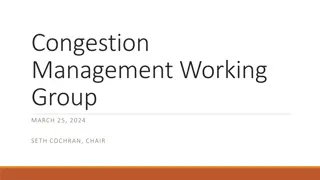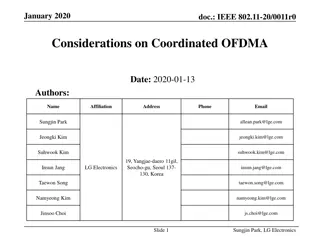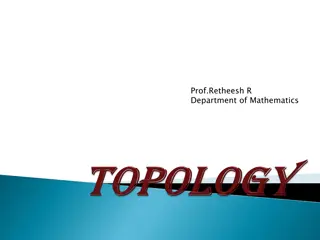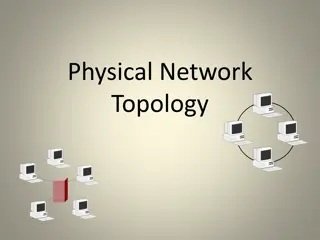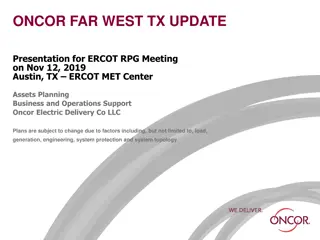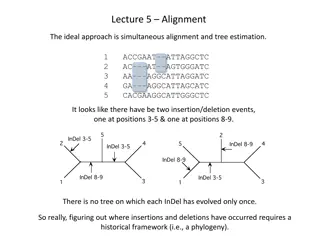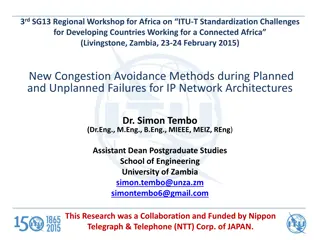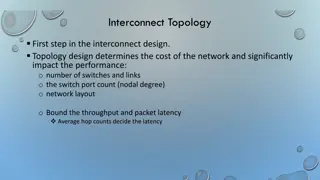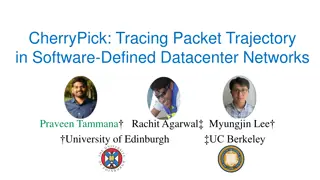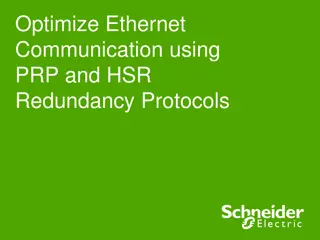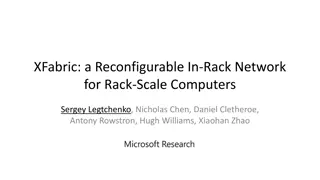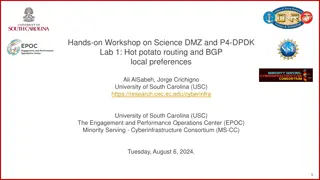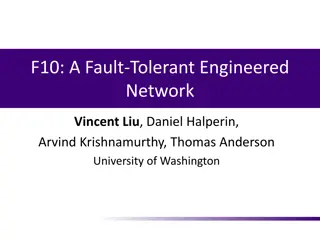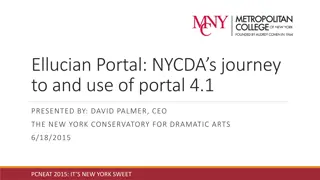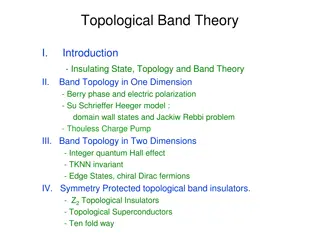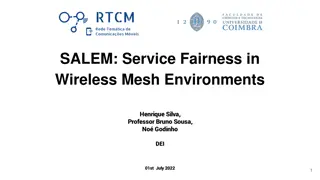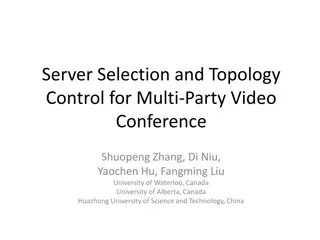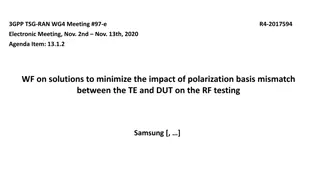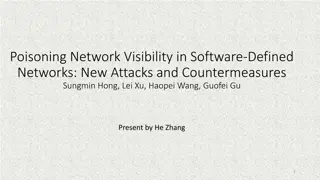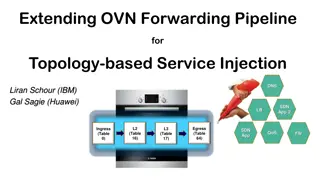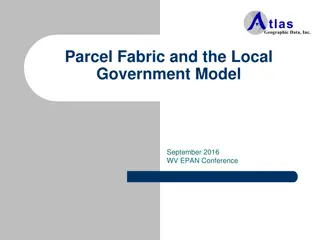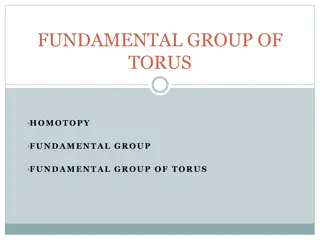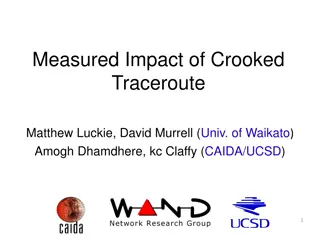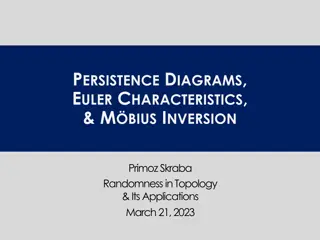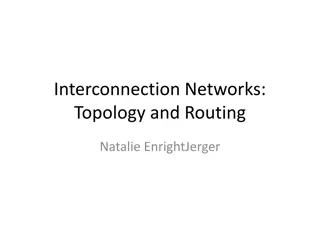Gain Analysis for Coordinated AP Transmissions in IEEE Enterprise R3 Network
This document discusses gain analysis results for coordinated AP transmissions in the IEEE Enterprise R3 network, focusing on tail latency gain for aperiodic traffic. Simulation setups, topology details, and results for different coordination schemes (C-TDMA, C-RTWT, and combined) are provided, show
5 views • 6 slides
Understanding Computer Networks: Basics, Components, and Topologies
Computer networks are essential for sharing resources, exchanging files, and enabling electronic communications. This includes components like senders, receivers, messages, transmission media, and various modes of communication. The need for networking arises from file sharing, resource sharing, com
14 views • 28 slides
Electric Grid Congestion Management Updates
Working Group updates on congestion management strategies including proposed fixes for reliability deployment pricing, mitigations for ESRs, and congestion mitigation using topology reconfigurations. Discussions covered locational price signals, resource payments, offer cap designs, and operational
0 views • 4 slides
Understanding Mesh and Star Network Topologies
Network topology plays a crucial role in network performance and maintenance costs. Mesh topology connects every device with a dedicated link, providing reliability and security. On the other hand, star topology connects devices to a central hub, ensuring communication through the hub. Explore the a
0 views • 22 slides
Considerations on Coordinated OFDMA Operation in IEEE 802.11
The document discusses the Coordinated OFDMA (C-OFDMA) operation as a part of Multi-AP coordination schemes within the IEEE 802.11 standard. It covers resource allocation options, topology considerations, resource allocation methods, capability announcement procedures, and negotiation processes betw
0 views • 15 slides
Introduction to Topological Spaces and Examples
Topology is the study of surfaces derived from Greek words meaning surface and discourse. In mathematics, a topological space is a set with a family of subsets satisfying specific properties. Examples include the open ball, open set, indiscrete topology, discrete topology, co-finite topology, and co
0 views • 14 slides
Understanding Physical Network Topologies
Physical network topology refers to the layout of cables, computers, and peripherals in a network, distinct from logical topology. Common physical topologies include Star, Ring, Linear Bus, Tree, and Mesh. Each topology has its advantages and disadvantages, impacting network performance and reliabil
0 views • 16 slides
Understanding IEEE 802.11-20/0410r4 Coordinated Spatial Reuse Procedure
This document presents the Coordinated Spatial Reuse (CSR) procedure in IEEE 802.11-20/0410r4, focusing on the transmission schemes and necessary information for effective spatial reuse. It outlines the topology of CSR environments, acquisition of information for CSR, CSR capability announcement by
8 views • 23 slides
Oncor Far West TX Transmission Projects Overview
This presentation outlines the Oncor Far West Texas transmission projects approved by ERCOT, including planned developments for 2019. The projects aim to enhance the reliability and efficiency of the electrical grid in the region, catering to factors like load, generation, engineering, system protec
0 views • 8 slides
Understanding EIGRP: A Comprehensive Overview
Enhanced Interior Gateway Routing Protocol (EIGRP) is a dynamic routing protocol providing various advantages to network administrators. It is a classless routing protocol supporting VLSM and is considered an Interior Gateway Protocol (IGP). EIGRP uses advanced distance vector routing and is known f
1 views • 5 slides
Understanding Quotient Spaces in Mathematics
In group theory, a subgroup H of a group G helps decompose G into equal-size disjoint subsets called cosets. Quotient spaces in mathematics involve equivalence classes under a given relation and a specific topology. Furthermore, in linear algebra, the quotient of a vector space by a subspace results
0 views • 8 slides
Advancements in Signal Processing for ProtoDUNE Experiment
The team, including Xin Qian, Chao Zhang, and Brett Viren from BNL, leverages past experience in MicroBooNE to outline a comprehensive work plan for signal processing in ProtoDUNE. Their focus includes managing excess noise, addressing non-functional channels, and evolving signal processing techniqu
1 views • 23 slides
Progressive Alignment Overview in Phylogenetics
In the field of phylogenetics, the process of progressive alignment is crucial for aligning sequences and building evolutionary trees. This approach involves generating pairwise alignments, estimating distances, constructing guide trees, and aligning sequences progressively based on the tree. Needle
0 views • 12 slides
New Congestion Avoidance Methods for IP Networks
This research presentation highlights the challenges of IP network failures, focusing on planned and unplanned scenarios. Dr. Simon Tembo discusses innovative methods to prevent congestion during failures, including a backup topology design for unplanned failures and a congestion avoidance approach
2 views • 40 slides
SAT-Based Exact Synthesis Using DAG Topology Families
Explore the world of exact synthesis in digital circuit design utilizing SAT solvers to achieve precise results. Understand the challenges, decision problems, algorithms, motivation behind exact synthesis, and the contribution of SAT solvers in mitigating runtime. Discover the concept of DAG topolog
0 views • 17 slides
Understanding Interconnect Topology Design and Performance Metrics
Interconnect topology design plays a crucial role in determining the cost and performance of a network. Factors such as the number of switches and links, switch port count, network layout, throughput, packet latency, average hop counts, nodal degree, hop count, and diameter are essential considerati
0 views • 38 slides
Enhancing Network Debugging with CherryPick in Software-Defined Datacenter Networks
Explore CherryPick, a technique for tracing packet trajectory in software-defined datacenter networks. It helps in debugging by ensuring data plane conforms with control plane policies, localizing network problems, and enabling packet trajectory tracing challenges like non-shortest paths. CherryPick
0 views • 14 slides
Understanding Interconnection Networks Topology
Exploring the topology of interconnection networks helps determine the arrangement of channels and nodes, impacting network cost, performance, latency, energy consumption, and complexity of implementation. Abstract metrics such as degree, hop count, and network diameter play crucial roles in evaluat
1 views • 56 slides
Exploring Bluetooth Technology and IoT Initiative at University of Notre Dame
Dive into the world of Bluetooth technology and the Internet of Things (IoT) through the 2018 Summer Engineering Program at the University of Notre Dame. Learn about the innovative Bluetooth's history, key characteristics, topology including piconet and scatternet, and more. Get insights into Blueto
0 views • 28 slides
Optimizing Ethernet Communication with PRP and HSR Redundancy Protocols
Explore how to optimize Ethernet communication using Parallel Redundancy Protocol (PRP) and High-availability Seamless Redundancy (HSR) protocols. PRP is ideal for connecting a large number of IEDs with the same application, while HSR is preferred for smaller networks with a single ring topology. Di
0 views • 23 slides
Exact Byzantine Consensus on Undirected Graphs: Local Broadcast Model
This research focuses on achieving exact Byzantine consensus on undirected graphs under the local broadcast model, where communication is synchronous with known underlying graphs. The model reduces the power of Byzantine nodes and imposes connectivity requirements. The algorithm involves flooding va
0 views • 7 slides
Meridian: An SDN Platform for Cloud Network Services
Meridian is an SDN platform developed by Mohammad Banikazemi, David Olshefski, Anees Shaikh, John Tracey, and GuohuiWang at IBM T. J. Watson Research Center. The platform focuses on providing cloud network services efficiently. It encompasses an architecture that enables faster and more convenient n
0 views • 21 slides
Reconfigurable In-Rack Network for Rack-Scale Computers
Designing a reconfigurable in-rack network to enhance performance and reduce costs in rack-scale computers. The XFabric project focuses on adapting network topology to traffic flow, resulting in lower path lengths and reduced oversubscription. By implementing circuit-switched fabric with electrical
0 views • 21 slides
The Logical Structure of Classical and Quantum Mechanics
The paper explores the common logical structure shared between classical and quantum mechanics, emphasizing the non-distributive lattice embedded in a distributive one. It discusses how all physical theories must adhere to this structure, incorporating topology, Heyting algebra, Boolean algebra, and
1 views • 36 slides
Smart Campus Full Stack Project Database Migration by Nadav Gvili
A real-time system with an interactive web interface for managing campus facilities, extending the scope of a previous project. Stakeholders include campus visitors, lessees, and organizational management, with features like facility monitoring and an architecture shift to PostgreSQL and MongoDB wit
0 views • 12 slides
Hands-On Workshop on Science DMZ and P4-DPDK Lab
Join the workshop at the University of South Carolina to learn about hot potato routing, BGP local preferences, and hands-on lab activities focusing on network topologies and configurations. Explore the Lab Topology, Lab Configuration, and Platform Information for an interactive learning experience
0 views • 6 slides
Fault-Tolerant Engineered Networks Overview
Explore the design and challenges of fault-tolerant engineered networks such as FatTrees, with a focus on recovery strategies, topology innovations, and failure detection mechanisms. Learn about the co-design of topology, routing protocols, and failure detectors for optimal performance in data cente
0 views • 27 slides
Ellucian Portal: NYCDAs Journey and Upgrade Process
Presentation by David Palmer, CEO of The New York Conservatory for Dramatic Arts, discussing the journey to and use of Ellucian Portal 4.1 at PCNEAT 2015. Details include goals for a single access point, ease of use, and management, as well as the transition from PowerCampus Portal to SharePoint to
0 views • 8 slides
Exploring Topological Band Theory and Quantum Phases in Electronic Matter
Delve into the fascinating realm of topological band theory, examining the insulating state, band topology in different dimensions, symmetry-protected topological band insulators, and the interplay between symmetry and topology. Uncover the principles underlying matter symmetry, quantum phases, and
0 views • 29 slides
SALEM: Service Fairness in Wireless Mesh Environments
SALEM project focuses on managing resources intelligently in Wireless Mesh Networks to ensure fairness among services with heterogeneous technologies. Implementing a fairness model incorporating delay, reliability, and energy objectives, SALEM is tested in smart city scenarios. Through MILP optimiza
0 views • 11 slides
SEAL: Scalable Memory Fabric for Silicon Interposer-Based Systems
SEAL lab focuses on designing a scalable hybrid memory fabric for silicon interposer-based multi-core systems to support memory-intensive applications like in-memory computing. The lab's research aims to provide low-latency, high-bandwidth processor-memory communication through innovative topology,
0 views • 27 slides
Optimizing Multi-Party Video Conferencing through Server Selection and Topology Control
This paper proposes innovative methods for multi-server placement and topology control in multi-party video conferences. It introduces a three-step procedure to minimize end-to-end delays between client pairs using D-Grouping and convex optimization. The study demonstrates how combining D-Grouping,
0 views • 13 slides
Solutions to Minimize Polarization Basis Mismatch Impact in RF Testing
In the 3GPP TSG-RAN-WG4 Meeting #97-e, discussions focused on minimizing the impact of polarization basis mismatch between the TE and DUT in RF testing for Samsung devices. Various proposals were presented relating to EIRP measurement and methods to enhance testing procedures. Key topics included TP
0 views • 10 slides
Understanding Software-Defined Networking (SDN) Threats and Countermeasures
Software-Defined Networking (SDN) revolutionizes network management by separating control and data planes, providing flexibility, and enabling innovative flow handling. This presentation explores SDN concepts, OpenFlow protocol, operational distinctions from legacy networks, and the importance of to
0 views • 27 slides
Extending OVN Forwarding Pipeline for Topology-based Service Injection
Explore how to extend the OVN forwarding pipeline to enable topology-based service injection, allowing external applications to influence flow routes dynamically, such as for service chaining and DPI. The extensible pipeline facilitates the interaction with base OpenFlow pipelines, distributed netwo
0 views • 17 slides
Parcel Fabric and Local Government Model - Data Migration Process
Explore the data migration process for Parcel Fabric in the Local Government Model, covering topics such as the WV Factor, geometry requirements, topology rules, staging data, and checking results for successful load. Understand the challenges, conversion factors, and tools essential for migrating d
0 views • 17 slides
Understanding Homotopy and Fundamental Groups in Topology
Explore the concepts of homotopy and fundamental groups in topology, where objects with the same structure can be classified into classes, and the fundamental group characterizes loops. Discover the fundamental group of a torus, its identity elements, closure, associativity, and inverses. Homotopy a
0 views • 10 slides
Understanding the Impact of Crooked Traceroute on Network Topologies
Traceroute-based algorithms play a crucial role in collecting network topology data, but the introduction of per-flow load balancing has raised concerns about the accuracy of these algorithms. This study examines the implications of crooked traceroute on false link inference rates and the identifica
0 views • 23 slides
Randomness in Topology: Persistence Diagrams, Euler Characteristics, and Möbius Inversion
Exploring the concept of randomness in topology, this work delves into the fascinating realms of persistence diagrams, Euler characteristics, and Möbius inversion. Jointly presented with Amit Patel, the study uncovers the vast generalization of Möbius inversion as a principle of inclusion-exclusio
0 views • 57 slides
Understanding Interconnection Networks: Topology and Routing
Interconnection networks play a crucial role in determining the arrangement of channels and nodes within a network, similar to a road map guiding traffic flow. Topology overview defines the network structure, while abstract metrics help evaluate performance and cost. Latency and throughput are key f
0 views • 49 slides


